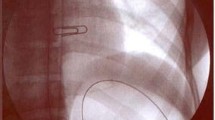Abstract
Corrosive strictures of the esophagus are difficult to treat, however, prompt and appropriate management of corrosive burns to the esophagus can prevent the formation of strictures. In a developing country like India, where facilities for early treatment are not easily available, strictures are an ineviatable consequence. If the strictures are extensive, dilatational therapy proves ineffective and offers no substantial benefit to the patients. Twenty patients with extensive corrosive strictures of the esophagus were surgically managed; by esophageal bypass in 13 and esophagectomy in 7. Surgical treatment restored normal swallowing in all the patients. The common post-operative complications to occur were: pulmonary complications, anastomotic leak and stricture, gastric outlet obstruction and reflux esophagitis. For extensive corrosive strictures of the esophagus, we advocate early surgical treatment rather than prolonged dilatational therapy.
Similar content being viewed by others
References
Thomas AN, Dedo HH, Lim RC, Steele M. Pharyngoesophageal caustic strictures. Treatment by pharyngogastrostomy compared to colon interposition continued with free bowel graft. Am J Surg 1976; 132: 195–203.
Marchand P. Caustic strictures of the esophagus. Thorax 1965; 10: 171–176.
Moody FG, Garret JM. Esophageal achalasia following lye ingestion. Ann Surg 1969; 170: 775–779.
Gupta S. Total obliteration of esophagus and hypopharynx due to corrosives. A new technique of reconstruction. J Thorac Cardiovasc Surg 1970; 60: 264–268.
Imre J, Kopp M. Arguments against long term conservative treatment of esophageal strictures due to corrosive burns. Thorax 1972; 27: 594–598.
Campbell GS, Burnott HF, Ranson JM, Williams GD. Treatment of corrosive burns of the esophagus. Arch Surg 1977; 112: 495–500.
Alvarez AF, Colbert JG. Lye stricture of the esophagus complicated by carcinoma. Canad J Surg 1963; 6: 470–475.
Sytnik AP, Petrov BA. Cancer of the esophagus in post burn cicatrical stenosis. Khirurgiya 1968; 44: 3.
Orringer MB. Transhiatal esophagectomy for benign disease. J Thorac Cardiovasc Surg 1985; 90: 649–655.
Raptis S, Milne DM. A review of the management of 100 cases of benign strictures of the esophagus. Thorax 1972; 27: 599–603.
Mullen DC, Young WG, Sealy WC. Results of twenty years experience with esophageal replacement for benign disorders. Ann Thorac Surg 1968; 5: 481–488.
Aleem AA, Jamjoom A, Mokhtar A, Ghafouri H. Management of corrosive strictures of the esophagus in children. Ann Paed Surg 1984; 1: 123–125.
Clark J, Moraldi A, Moosa AR, Hall AW, De Meester TR, Skinner DB. Functional evaluation of the interposed colon as an esophageal substitute. Ann Surg 1976; 183: 93–100.
Author information
Authors and Affiliations
Rights and permissions
About this article
Cite this article
Chattopadhyay, T., Kapoor, V. & Gupta, S. The management of extensive corrosive esophageal strictures: Do not dilate and procrastinate. The Japanese Journal of Surgery 19, 171–176 (1989). https://doi.org/10.1007/BF02471581
Received:
Issue Date:
DOI: https://doi.org/10.1007/BF02471581




